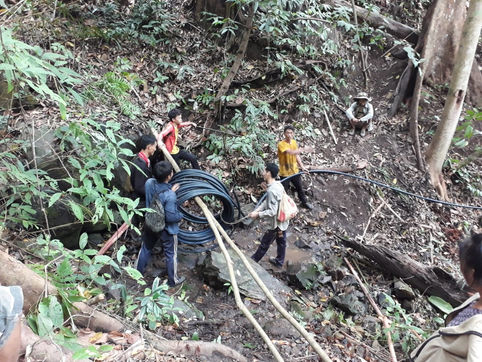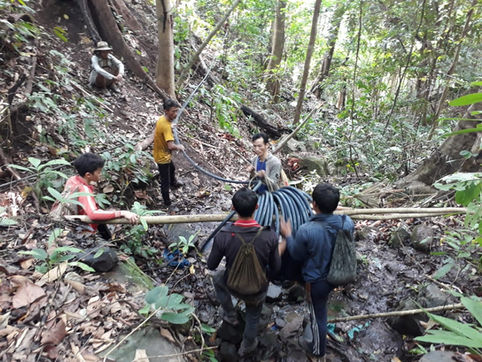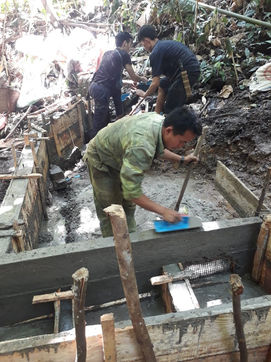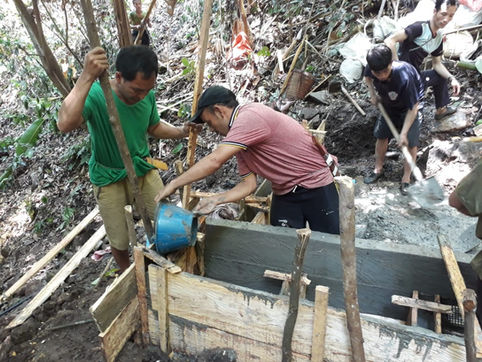Water pipeline
Water woes: upgrading the supply. By the end of each dry season in May streams dry up and the village water supply runs perilously low. Village women are burdened with carrying water uphill from a secondary source below the village, which limits the amount that can be supplied. Houses with metal roofs collect infrequent rains on the cusp of the rainy season. The proposal is to install a 32 mm PVC pipe from a more reliable source 3 km up the mountain. The cost for the project is in the neigbourhood of $3,000 CAD.
The existing supply. The main village water supply is gravity-fed and sourced from a very small reservoir/dam located in a stream just above the village. It was sponsored by one of the businessmen who buy animals and produce from the village. The two photos above – taken in May, 2018 – show good pressure early in the day. Problems occur later in the day since the stream flow is too low to replenish the reservoir and support demand. Water is used for both human and animal consumption; excluding showers, water for humans must be boiled.
The reservoir. The photos below highlight the the limitations of the current arrangement. Photo 1 shows two young men on the dam; notice the approximate 5 cm (2 inch) drop in water level indicated by the wet mark on the wall due to village consumption. The 2nd photo looks back from where the standing guy was and into the reservoir. That's not a lot of water! Look closely in the top center of this photo to see the dribble of stream flow.
Impressive buttresses are prominent in the 3rd photo on the downstream side; remember, rainy season water flows can be torrential (see erosion in the 7th photo). The overflow spillway appears in the 4th photo and seems to be at most 1.5 feet (46 cm) above the bottom of the pool, which limits storage capacity.
The paltry supply stream is again visible in the center, background of the tilted 6th photo; not much for a village of about 400 people.
In the 7th photo the young man in the blue shirt is stepping over the tubing that carries water back to the village. Notice the significant erosion; one can imagine water gushing down during a downpour in the rainy season.
Why not simply enlarge the existing reservoir/dam ? Since the stream flow rate during the dry season is nowhere near sufficient to comfortably supply the village, a large amount of water would need to be contained – perhaps 3 months worth, which might mean a stored volume 50 to 100 times larger, or more. A much larger reservoir would require considerable concrete and labour to build. More importantly, the small size of the existing reservoir may, in fact, be an advantage: constant inflow and outflow leads to little stagnation. Given the tropical temperatures, a larger system with still water would be susceptible to algal blooms and growth of bacteria, and possibly attracting animals and accompanying leptospirosis. Doubtless it would have to be flushed out regularly defeating the enlargement.
The new pipeline The existing water reservoir dried up in mid-March as indicated in the photo below. This has required village women, who are tasked with such things, to carry water a distance of 800 m (2,600 ft) up an elevation of 130 m (425 ft). Given that the water is not only for human consumption (drinking, cooking, bathing), but also for animals and vegetable gardens, this would appear a very onerous task. A decision was made to tap into a better source.

Here is the project budget prepared by Bounchan Her.
21,415,000 Kip is equivalent to $2,864 CAD $2,272 USD as of April 20, 2021.

After considering four potential routes for a new pipeline running from three locations, including one that involved pumping water 130 m vertically from below the village, a final route for the gravity fed system has been decided on and is shown on both a Google Earth image and a photo of the mountain where a small stream is located. The pipeline length will be approximately 2.3 km (1.43 miles). (The village stretches across the foreground of mountain photo, the haze is due to the burning of fields in preparation for the planting of rice.)
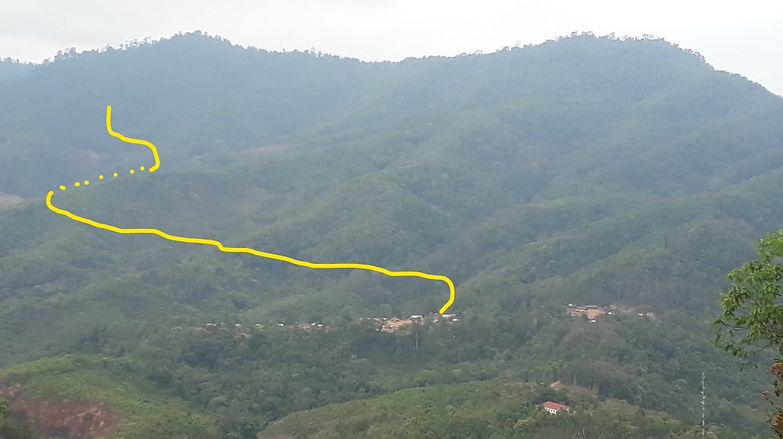

Technical concerns. The higher the dam is above the village, the greater the water pressure in the pipeline at the bottom. The final location of our dam is 316 m above the village tap, which produces a pressure of 449 psi (pounds/sq.inch). The maximum operating pressure for the 1 1/4 ” (32 mm) PVC pipe that we’re using is 221 psi – equivalent to a height difference of 156 m, and the bursting pressure is 1180 psi – equivalent to 831 m. Our pipeline will be operating at just over twice the maximum operating pressure; so, we’re pushing the limit. (As Scotty on Star Trek would say: the pipeline “can’nae take anymore, Captain!”)
By comparison, WWII submarines had a maximum operating depth of 280 to 300 m after which the hull and pipes would fail due to the pressure.
Typical water pressure in North American municipal systems seems to be 40 to 80 psi; with 100 psi the maximum – although a Google search indicated that in Georgia pressure is sometimes “well above 140 psi”.
In the event of catastrophic failure, plan B is to build a break-pressure tank halfway down to reset the pressure to zero, and hope that not too much pipe needs to be replaced.

Pipeline completed, and it works!! After 4 1/2 days work – which is surely a record – the pipeline was completed, and on April 20th, 2021 the village tap turned on. There were no catastrophic problems due to the high pressure. In fact, water flow out of the tap is remarkably benign.
In the 1st two photos village women are able to bathe and wash hair for the first time since early March when the old dam ran dry. Clothes are also being washed. (Notice the two solar panels above the women in the 2nd photo.) The 3rd photo shows the stream 800 m south of the village that women had been using for washing and as a source of water; there are clothes drying in the background. (We’d been considering this stream as a source of water, but there were no solar-powered surface pumps available in Luang Prabang, and the height difference of 130 m would have required a holding tank halfway up and a second pump.)
In the last photo 3 boys are playing in the newly available water. Additional photos will be posted as they become available.
The timeline of project construction follows in chronological order below (oldest to most recent).
Transporting materials. On Friday, April 2, loads of sand & gravel, ten 50 kg (110 lbs) bags of cement, and 14 lengths of rebar were delivered to the village. Due to what appears to be an early start to the rainy season (usually mid-May) dam construction has been delayed by about a week. The first task will be to improve the track up the mountain to allow passage of a Chinese Buffalo tractor which will bring the materials up. As the dam site is some 400 m in distance below the track, some difficulty is expected in getting materials to the site.
The photos below start with 7 villagers trekking up to check the dam site, followed by two showing some of the materials. Underneath is a video indicating the stream flow.
Construction Day 1 Monday, April 12th Excavation The first 3 photos were taken in Fahmieng on Sunday prior to transporting materials up the mountain. Sand & gravel were being bagged ready for transport via Chinese Buffalo tractors to near the dam site. That’s Bounchan’s mom, Daw, on the left of the 1st photo. The bags were carried and dragged down to the site over a distance of about 300 m – photo 4. Smiles before the excavation begins – photo 5. Clearing the surface rocks in photos 6 & 7 – surprisingly poor soil. The boards in the background of photo 11 will be used to make forms for the concrete. The stream will have to be diverted before the concrete is poured. The guys in the last photo look like they were posing for a music video.
Construction – day 2 Tuesday April 13 Forms & Concrete Work began on the dam & reservoir using improvised equipment and techniques. The photos show the building of forms, installation of rebar, and mixing and pouring of concrete – one bucket at a time.
Construction – day 2 Tuesday April 13 Laying the pipe. While concrete work was progressing on the dam, another crew started laying pipes. To avoid tangles and creating damaging kinks in the PVC tubing, the pipe was unwound from a small tree trunk axle. Eventually all of the pipeline will be buried in shallow trenches. The burnt hillside in two of the photos is an effort to expand areas of upland rice cultivation in view of the hardship caused by the rice leaf blight in 2020 which reduced harvests by up to 70%.
Construction – day 3 Wednesday, April 14 Progress on dam. Work is proceeding rapidly and should be completed before the end of April, possibly by the end of the coming week. The dam/reservoir is starting to take shape, and the design is becoming clear. The turquoise tube at the bottom center of the 1st photo appears to be a bypass for the stream during construction. The concrete from day 2 has not yet hardened, care must be taken not to hit it. Let us hope that the stream does not leak into the concrete floor before it dries. In the last photo, between the stripped sandals, the red handle of a valve is apparent.
Construction – day 3 Wednesday, April 14 Pipeline update. Construction will be on a pause due to Lao New Year celebrations that extend over at least 3 days, but progress has been remarkable and the project should be completed before the end of April, possibly even April 24th. The 2.3 km pipeline is, apparently and surprisingly, almost completed – after 3 days.
About 37 to 40 mostly young men participate each day, and it is heart-warming to see them toiling away on a project to benefit the entire village.
As the dam site is small, only about 7 or 8 people work there. The remaining 30-plus guys are split into teams. The 3rd photo shows one team back at the village about to start laying pipe up the mountain to link up with the downhill team – much like the building of various railways & tunnels. What strikes me is how everyone manages to stay clean; I think I’d at least have dirty jeans!
Bounchan, our dedicated project coordinator, appears by himself in the 6th photo – orange tee shirt.
Pipeline wrap-up: The 2.3 km pipeline project was completed after 4 ½ days, which is truly impressive. The 1st two photos show women enjoying an end-of-day shower. The last photo shows the reservoir slowly filling up; there will eventually be a cover over most of it








































